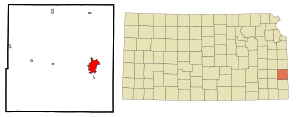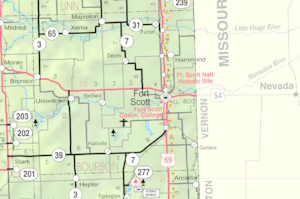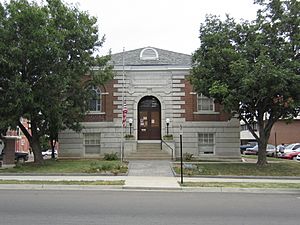Fort Scott, Kansas facts for kids
Quick facts for kids
Fort Scott, Kansas
|
|
|---|---|
|
City and County seat
|
|

Downtown Fort Scott (2024)
|
|

Location within Bourbon County and Kansas
|
|

|
|
| Country | United States |
| State | Kansas |
| County | Bourbon |
| Founded | 1850s |
| Platted | 1857 |
| Incorporated | 1860 |
| Named for | Gen. Winfield Scott |
| Area | |
| • Total | 5.63 sq mi (14.58 km2) |
| • Land | 5.59 sq mi (14.47 km2) |
| • Water | 0.04 sq mi (0.11 km2) |
| Elevation | 843 ft (257 m) |
| Population
(2020)
|
|
| • Total | 7,552 |
| • Density | 1,341.4/sq mi (517.97/km2) |
| Time zone | UTC-6 (CST) |
| • Summer (DST) | UTC-5 (CDT) |
| ZIP code |
66701
|
| Area code | 620 |
| FIPS code | 20-24000 |
| GNIS ID | 485575 |
Fort Scott is a city in Kansas, United States. It is the main city and government center of Bourbon County. The city was named after General Winfield Scott.
In 2020, about 7,552 people lived here. Fort Scott is located about 88 miles (142 km) south of Kansas City. It sits along the Marmaton River. The city is home to the Fort Scott National Historic Site and the Fort Scott National Cemetery.
Contents
History of Fort Scott
Fort Scott was first set up by the U.S. Army in 1842. Soldiers stayed there until 1853. Their job was to protect the border area known as the Permanent Indian Frontier. After the army left, local settlers bought the fort buildings in 1855. The town of Fort Scott was officially planned in 1857. It became a city in 1860.
Between 1855 and 1861, people in Fort Scott saw a lot of fighting. This happened before the American Civil War on the border between Kansas and Missouri. Newspapers at the time called this period "Bleeding Kansas". It was caused by big arguments across the country about whether new territories could have slavery.
Kansas became a free state on January 29, 1861. But the problems from "Bleeding Kansas" continued during the Civil War.
Fort Scott During the Civil War
During the Civil War, Fort Scott was a very important place for the U.S. Army. It was a main office, a place to store supplies, a training center, and a place where soldiers joined the army. It was key to protecting Kansas and the Midwest.
A battle happened near the fort in August 1861. It was called the Battle of Dry Wood Creek. In this battle, soldiers who supported the South won. However, they did not keep the fort. Instead, they moved north into Missouri.
Growth After the War
After the Civil War, Fort Scott became a leading city on the frontier. It was one of the biggest cities in eastern Kansas. Between 1870 and 1900, Fort Scott even competed with Kansas City. It wanted to become the biggest railroad hub west of the Mississippi River.
In the first half of the 1900s, Fort Scott became a center for farming and small factories. It still is today.
Downtown Fire in 2005
On March 11, 2005, a big fire happened in downtown Fort Scott. Several old buildings from the Victorian era were destroyed. These buildings were important symbols of the town's history.
Geography and Climate
Fort Scott is located on the Osage Plains, next to the Marmaton River. It is at the crossing of U.S. Routes 54 and 69 in southeast Kansas.
- It is about 54 miles (87 km) north of Joplin, Missouri.
- It is about 92 miles (148 km) south of Kansas City, Missouri.
- It is about 143 miles (230 km) east of Wichita, Kansas.
The city covers about 5.59 square miles (14.47 km2) of land. Only a small part, about 0.04 square miles (0.11 km2), is water.
Fort Scott's Climate
Fort Scott has a climate with hot, wet summers and cool winters. This is called a humid subtropical climate. The average temperature in Fort Scott is about 57°F (13.9°C).
- Temperatures often go above 90°F (32.2°C) about 53 days a year.
- Temperatures drop below 32°F (0°C) about 101 mornings a year.
- Fort Scott gets rain or snow about 83 days each year.
- The average snowfall is about 8.4 inches (21 cm) per year.
- The total rainfall is about 44.49 inches (1,130 mm) each year.
July is usually the hottest month, and January is the coolest. June is typically the wettest month. The highest temperature ever recorded was 120°F (49°C) in July 1954. The lowest was -24°F (-31°C) in February 1905.
| Climate data for Fort Scott, Kansas (1991–2020 normals, extremes 1896–present) | |||||||||||||
|---|---|---|---|---|---|---|---|---|---|---|---|---|---|
| Month | Jan | Feb | Mar | Apr | May | Jun | Jul | Aug | Sep | Oct | Nov | Dec | Year |
| Record high °F (°C) | 77 (25) |
84 (29) |
95 (35) |
97 (36) |
101 (38) |
107 (42) |
120 (49) |
113 (45) |
110 (43) |
99 (37) |
85 (29) |
75 (24) |
120 (49) |
| Mean maximum °F (°C) | 65.3 (18.5) |
70.9 (21.6) |
79.9 (26.6) |
84.0 (28.9) |
89.3 (31.8) |
94.8 (34.9) |
99.0 (37.2) |
99.9 (37.7) |
94.9 (34.9) |
86.3 (30.2) |
75.1 (23.9) |
66.7 (19.3) |
101.0 (38.3) |
| Mean daily maximum °F (°C) | 42.0 (5.6) |
47.6 (8.7) |
57.8 (14.3) |
67.7 (19.8) |
76.5 (24.7) |
85.9 (29.9) |
90.7 (32.6) |
89.8 (32.1) |
81.6 (27.6) |
69.9 (21.1) |
56.6 (13.7) |
45.7 (7.6) |
67.7 (19.8) |
| Daily mean °F (°C) | 32.0 (0.0) |
37.0 (2.8) |
46.5 (8.1) |
56.5 (13.6) |
66.3 (19.1) |
75.6 (24.2) |
80.3 (26.8) |
78.9 (26.1) |
70.3 (21.3) |
58.3 (14.6) |
46.1 (7.8) |
36.1 (2.3) |
57.0 (13.9) |
| Mean daily minimum °F (°C) | 21.9 (−5.6) |
26.4 (−3.1) |
35.3 (1.8) |
45.3 (7.4) |
56.0 (13.3) |
65.4 (18.6) |
70.0 (21.1) |
68.0 (20.0) |
59.0 (15.0) |
46.6 (8.1) |
35.5 (1.9) |
26.5 (−3.1) |
46.3 (7.9) |
| Mean minimum °F (°C) | 5.1 (−14.9) |
9.4 (−12.6) |
17.6 (−8.0) |
30.3 (−0.9) |
40.2 (4.6) |
53.2 (11.8) |
58.3 (14.6) |
57.1 (13.9) |
43.6 (6.4) |
29.9 (−1.2) |
19.8 (−6.8) |
8.7 (−12.9) |
0.6 (−17.4) |
| Record low °F (°C) | −19 (−28) |
−24 (−31) |
−6 (−21) |
16 (−9) |
25 (−4) |
41 (5) |
48 (9) |
42 (6) |
29 (−2) |
17 (−8) |
0 (−18) |
−18 (−28) |
−24 (−31) |
| Average precipitation inches (mm) | 1.44 (37) |
1.75 (44) |
2.92 (74) |
4.85 (123) |
6.19 (157) |
5.74 (146) |
4.63 (118) |
3.98 (101) |
4.46 (113) |
3.64 (92) |
2.84 (72) |
2.05 (52) |
44.49 (1,130) |
| Average snowfall inches (cm) | 3.9 (9.9) |
1.0 (2.5) |
0.7 (1.8) |
0.1 (0.25) |
0.0 (0.0) |
0.0 (0.0) |
0.0 (0.0) |
0.0 (0.0) |
0.0 (0.0) |
0.0 (0.0) |
0.4 (1.0) |
2.3 (5.8) |
8.4 (21) |
| Average precipitation days (≥ 0.01 in) | 5.9 | 5.0 | 6.8 | 8.6 | 10.2 | 9.2 | 7.2 | 6.0 | 6.2 | 6.8 | 6.1 | 5.3 | 83.3 |
| Average snowy days (≥ 0.1 in) | 2.0 | 0.6 | 0.5 | 0.0 | 0.0 | 0.0 | 0.0 | 0.0 | 0.0 | 0.0 | 0.2 | 1.0 | 4.3 |
| Source: NOAA | |||||||||||||
People in Fort Scott
| Historical population | |||
|---|---|---|---|
| Census | Pop. | %± | |
| 1860 | 262 | — | |
| 1870 | 4,174 | 1,493.1% | |
| 1880 | 5,372 | 28.7% | |
| 1890 | 11,946 | 122.4% | |
| 1900 | 10,322 | −13.6% | |
| 1910 | 10,463 | 1.4% | |
| 1920 | 10,693 | 2.2% | |
| 1930 | 10,763 | 0.7% | |
| 1940 | 10,557 | −1.9% | |
| 1950 | 10,335 | −2.1% | |
| 1960 | 9,410 | −9.0% | |
| 1970 | 8,967 | −4.7% | |
| 1980 | 8,893 | −0.8% | |
| 1990 | 8,362 | −6.0% | |
| 2000 | 8,297 | −0.8% | |
| 2010 | 8,087 | −2.5% | |
| 2020 | 7,552 | −6.6% | |
| U.S. Decennial Census | |||
2020 Census Information
The 2020 United States census counted 7,552 people living in Fort Scott. There were 3,080 households and 1,811 families. The city had about 1,352 people per square mile (522.0/km2).
Most people (about 84%) were white. About 5.5% were black or African-American. Other groups included Native American, Asian, Pacific Islander, and people of two or more races. About 3% of the population was Hispanic or Latino.
- About 24% of the people were under 18 years old.
- About 12% were between 18 and 24 years old.
- About 20% were 65 years or older.
- The average age in the city was 37 years.
2010 Census Information
In the census of 2010, there were 8,087 people living in Fort Scott. There were 3,285 households and 1,941 families. The city had about 1,457 people per square mile (562.6/km2).
- About 90% of the people were White.
- About 4.7% were African American.
- About 0.8% were Native American.
- About 0.6% were Asian.
- About 0.7% were from other races.
- About 2.9% were from two or more races.
- About 2.5% of the population was Hispanic or Latino.
The average age in the city was 35.2 years. About 25.5% of residents were under 18. About 18.1% were 65 or older.
Education in Fort Scott
Fort Scott has good options for learning, from colleges to schools for younger students.
Colleges
Fort Scott Community College was started in 1919. It is the oldest community college in Kansas.
Schools for Kids
The public schools in Fort Scott are part of the Fort Scott USD 234 district.
- There are two public elementary schools: Eugene Ware Elementary and Winfield Scott Elementary.
- There is one public middle school: Fort Scott Middle School.
- There is one high school: Fort Scott High School.
Fort Scott also has other schools:
- A Catholic school for grades K–5.
- Fort Scott Christian Heights for grades K–12.
- A few other small private schools for students from K–12.
- A public preschool in the old middle school building.
Fun Places to Visit
Gunn Park
Gunn Park is a large park, covering 155 acres. It has many things to do for families and friends.
- There are seven shelter houses, which are great for picnics. Four are enclosed, and three are open. You can reserve them at City Hall.
- The park has two lakes for fishing. From October 15 to April 15, Fern Lake is stocked with trout.
- There are many playground areas with new equipment.
- You can find 14 camping sites with electricity and water.
In 1999, a nine-hole Frisbee golf course was added. It was a team effort by the City of Fort Scott and the Kiwanis Club. Later, it was made into an 18-hole course.
The first stone shelter house was built in 1910 by Fern Lake. Long ago, there was a large wooden theater building by the lake that could seat 800 people. On special days like July 4th, up to 10,000 people would visit the park by streetcar.
Gunn Park also has about 6.5 miles of trails. These trails are great for mountain biking, trail running, and hiking. They go through the woods and along the Marmaton River.
Local Media
- Fort Scott Tribune: This is a newspaper that comes out twice a week. It started in 1884.
- KOMB 103.9 FM: This radio station plays classic and modern hits. It also has talk shows. You can listen to sports games like the Kansas Jayhawks, Kansas City Chiefs, Kansas City Royals, and local Fort Scott teams.
- KMDO 1600 AM: This radio station plays "Red dirt country" music. You can also hear it on 98.3 FM.
- KVCY 104.7 FM: This station broadcasts programs from VCY America.
Famous People from Fort Scott
Many interesting people have connections to Fort Scott:
- Richard Christy – a drummer and a personality on The Howard Stern Show
- Clark Clifford – he used to be the United States Secretary of Defense
- Jerry Elliott – a judge
- Charles Hatfield – known as a "rain maker"
- Mark Hart – a musician, songwriter, and producer
- William Hawkins – a U.S. Marine who received the Medal of Honor during World War II
- Stephen Johnson – a director of music videos
- Adam LaRoche – a retired Major League Baseball first baseman
- Andy LaRoche – a former major league third baseman for the Pittsburgh Pirates
- David Lowe – a judge in Kansas
- Bob Marshall – a Kansas state senator
- Elmer McCollum – a scientist who discovered vitamin A
- William McDonald – the first Governor of the State of New Mexico
- Gordon Parks – a famous photographer, author, filmmaker, and composer
- Lon Ury – a baseball player
See also
 In Spanish: Fort Scott para niños
In Spanish: Fort Scott para niños




